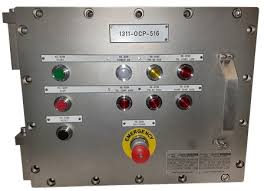
Understanding Control Panel Certification for Hazardous Locations
Industrial control panels operating in hazardous locations require specific certification to ensure safety and compliance. The choice between UL 508A and UL 121201 standards depends on the intended environment and regulatory requirements. This comprehensive guide explains the key differences and helps you choose the right certification path.
UL 508A: Industrial Control Panels
What is UL 508A?
UL 508A "Standard for Industrial Control Panels" is the primary standard for industrial control equipment intended for use in ordinary (non-hazardous) locations. It covers the construction and testing requirements for control panels used in general industrial applications.
UL 508A Scope and Applications
- Ordinary locations only: Not suitable for explosive atmospheres
- Industrial environments: Manufacturing, processing, automation
- Control functions: Motor control, process control, automation
- Component integration: Relays, contactors, PLCs, HMIs
- Safety features: Overcurrent protection, emergency stops
UL 508A Requirements
- Component selection: UL-listed components where required
- Wiring methods: NEC-compliant wiring practices
- Enclosure ratings: NEMA or IP ratings for environmental protection
- Short circuit protection: Proper overcurrent device coordination
- Grounding and bonding: Equipment grounding conductor requirements
UL 121201: Hazardous Location Control Panels
What is UL 121201?
UL 121201 "Standard for Electrical Equipment for Use in Class I, Zones 0, 1 and 2 Hazardous Locations" is specifically designed for equipment operating in explosive atmospheres. It incorporates protection methods that prevent ignition of flammable gases, vapors, or dusts.
UL 121201 Scope and Applications
- Hazardous locations: Class I, Zones 0, 1, and 2
- Explosive atmospheres: Gas, vapor, or dust environments
- Oil and gas: Refineries, petrochemical plants
- Chemical processing: Manufacturing facilities
- Mining operations: Underground and surface mining
UL 121201 Protection Methods
- Flameproof (Ex d): Contains internal explosions
- Intrinsically Safe (Ex i): Limits energy to prevent ignition
- Increased Safety (Ex e): Prevents sparking and excessive temperatures
- Pressurized (Ex p): Maintains positive pressure
- Encapsulation (Ex m): Seals components in compound
Key Differences: UL 508A vs UL 121201
| Feature | UL 508A | UL 121201 |
|---|---|---|
| Application Environment | Ordinary (non-hazardous) locations | Hazardous locations (explosive atmospheres) |
| Protection Methods | Environmental protection (NEMA/IP ratings) | Explosion protection (Ex methods) |
| Component Requirements | UL-listed components | Hazardous location certified components |
| Enclosure Design | Standard industrial enclosures | Explosion-proof or intrinsically safe design |
| Temperature Limits | Standard operating temperatures | Temperature class limits (T1-T6) |
| Installation Requirements | NEC general requirements | NEC 500/505 hazardous location requirements |
| Testing Requirements | Standard electrical safety tests | Explosion testing and temperature rise tests |
| Marking Requirements | UL 508A listing mark | UL 121201 + protection method + temperature class |
Certification Process Comparison
UL 508A Certification Process
- Design review: Panel layout and component selection
- Component verification: Ensure all components are UL-listed
- Construction evaluation: Wiring methods and assembly practices
- Testing: Dielectric withstand, temperature rise, short circuit
- Documentation: Bill of materials, wiring diagrams, instructions
- Follow-up service: Periodic factory inspections
UL 121201 Certification Process
- Hazardous location assessment: Determine zone classification
- Protection method selection: Choose appropriate Ex protection
- Component certification: All components must be hazardous location certified
- Design evaluation: Explosion protection design review
- Explosion testing: Verify protection method effectiveness
- Temperature testing: Ensure compliance with temperature class
- Documentation: Detailed technical documentation
- Ongoing compliance: Regular factory inspections
Cost and Timeline Considerations
UL 508A Certification
- Timeline: 4-8 weeks typically
- Cost: $5,000 - $15,000 depending on complexity
- Testing: Standard electrical safety tests
- Ongoing costs: Annual follow-up service fees
UL 121201 Certification
- Timeline: 12-24 weeks typically
- Cost: $15,000 - $50,000 depending on protection method
- Testing: Explosion testing, temperature rise, additional safety tests
- Ongoing costs: Higher annual follow-up service fees
When to Choose Each Standard
Choose UL 508A When:
- Control panel operates in ordinary (non-hazardous) locations
- No explosive gases, vapors, or dusts are present
- Standard industrial environment applications
- Cost and timeline are primary concerns
- General manufacturing or processing applications
Choose UL 121201 When:
- Control panel operates in hazardous locations
- Explosive atmospheres are present or likely
- Oil and gas, chemical, or mining applications
- Safety is the primary concern
Installation and Maintenance Considerations
UL 508A Installation
- Follow NEC general requirements
- Ensure proper grounding and bonding
- Verify enclosure environmental rating
- Regular maintenance and inspection
UL 121201 Installation
- Follow NEC 500/505 hazardous location requirements
- Proper sealing and conduit requirements
- Verify protection method integrity
- Specialized maintenance procedures
- Qualified personnel requirements
Common Pitfalls and Best Practices
Avoid These Common Mistakes:
- Wrong standard selection: Using UL 508A in hazardous locations
- Component mismatch: Mixing ordinary and hazardous location components
- Installation errors: Not following proper sealing requirements
- Maintenance issues: Using non-certified replacement parts
- Documentation gaps: Incomplete technical documentation
Best Practices:
- Early planning: Determine certification requirements early in design
- Expert consultation: Work with hazardous location specialists
- Component selection: Choose certified components from the start
- Quality control: Implement strict quality control procedures
- Training: Ensure personnel are trained on requirements
Conclusion
Choosing between UL 508A and UL 121201 for control panel certification is a critical decision that affects safety, compliance, and operational costs. While UL 508A is suitable for ordinary industrial applications, UL 121201 is essential for hazardous location environments where explosive atmospheres are present.
The additional cost and time required for UL 121201 certification is justified by the enhanced safety requirements and protection methods that prevent catastrophic incidents in explosive atmospheres. Always consult with hazardous location engineering specialists to ensure proper certification selection and implementation.